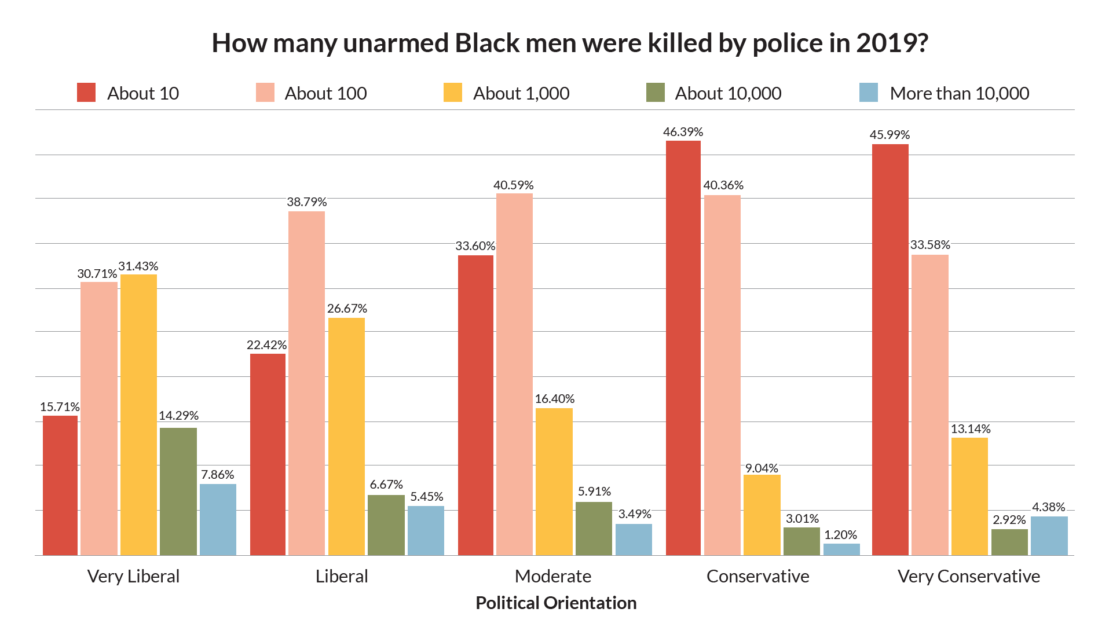Anyone who regularly consumes media or just casually monitors the state of race relations over the past two decades will likely have the perception that society is being torn apart over issues of race. In fact, polls support that perception. Gallup, for example, began tracking data in the early 2000s on the “perception of positive race relations among Black and White U.S. adults.” As evident in the graph below, the perception that people are able to see past racial differences and get along is at its lowest level in decades.1 The pattern of race relations is interesting. Throughout the 2000s and into the early 2010s, most people—White or Black—tended to perceive race relations as improving. That changed suddenly in 2014 with a plunge in race relations that continues to the present day.
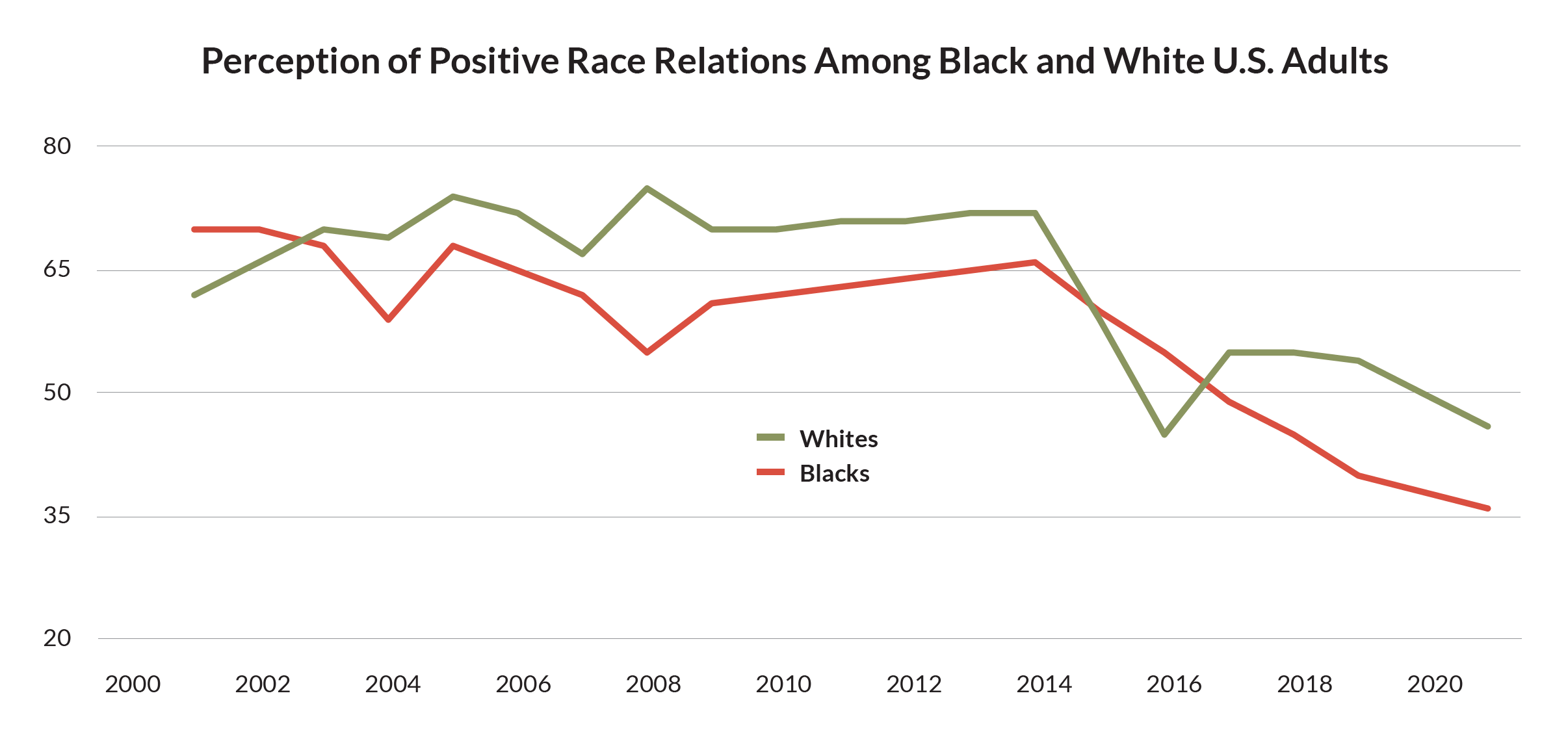
Figure 1
It is important to understand how this happened. One possibility is that things have gotten worse and that racism has made a stunning comeback in some form. However, the data don’t bear that out. It is widely understood that explicit racism, such as the belief that people from different races are less valuable, not as smart, shouldn’t marry people from other races, etc., has experienced a remarkable decline since the Civil Rights era. Pollsters, for example, used to routinely ask how Americans feel about interracial marriage. It wasn’t until 1967 and the landmark decision in Loving v. Virginia that the U.S. Supreme Court ruled that laws banning interracial marriage violate the Equal Protection and Due Process clauses of the 14th Amendment to the U.S. Constitution. Today, the legality of interracial (and indeed same-sex) marriage is protected by the case law and widely accepted by the public.
Such trends in race relations have led some to argue that polls only measure explicit bias, whereas implicit bias remains unconscious. Hidden bias can be, purportedly, measured through what is known as the Implicit Association Test (IAT). It is claimed to identify unconscious biases (including racism, misogyny, ableism, and others), even among members of the oppressed minority, thus making them “self-hating.” The task for measuring racial bias, for example, asks participants to sort Black and White faces (by pressing computer keys) into one of two categories: European American or African American. The participants are then tasked with sorting a list of words (Joy, Terrible, Love, Agony, Peace, Horrible, Wonderful, Nasty…) into categories of either “Good” or “Bad.” Then, the words and the Black and White faces appear on the screen one at a time, and the participants are asked to sort them into categories of either African American/Good or European American/Bad. The word “joy,” for example, would go into the “Good” category, while a White face would go into the second category. This sorting process goes noticeably slower. Finally, participants are tasked with sorting the words and faces into the categories of European American/Good or African American/Bad. Many respond more quickly when White faces are paired with positive words and when Black faces are paired with negative words. That reaction time difference is claimed to be a measure of their implicitly racist attitudes toward African Americans because it’s harder for the participants’ unconscious minds to link African Americans with positive words.
The scientific validity of the IAT, however, has taken a hit in recent years.2 As the renowned social psychologist Carol Tavris wrote in Skeptic:
It was unclear what those microsecond “associations” meant; it seemed a leap to call it a measure of prejudice; at best it seemed simply to be capturing a familiar cultural association or stereotype, in the same way that people would be quicker to pair bread + butter than bread + avocado. A person of any age might be aware of negative associations between old people and mental decline without being prejudiced against old people in general. One team got an IAT effect by matching target faces with nonsense words and neutral words that had no evaluative connotations at all. They concluded that the IAT does not measure emotional evaluations of the target but rather the salience of the word associated with it—how much it stands out—and negative words attract more attention. When they corrected for these factors, the presumed unconscious prejudice faded away.3
In his Scientific American column on the subject Michael Shermer wrote of the IAT:
I’m skeptical. First, unconscious states of mind are notoriously difficult to discern and require subtle experimental protocols to elicit. Second, associations between words and categories may simply be measuring familiar cultural or linguistic affiliations—associating blue and sky faster than blue and donuts does not mean I unconsciously harbor a pastry prejudice. Third, negative words have more emotional salience than positive words, so the IAT may be tapping into the negativity bias instead of prejudice. Fourth, IAT researchers have been unable to produce any interventions that can reduce the alleged prejudicial associations. A 2016 meta-analysis by Patrick Forscher and his colleagues published on the Open Science Framework examined 426 studies on 72,063 subjects and “found little evidence that changes in implicit bias mediate changes in explicit bias or behavior.” Fifth, the IAT does not predict prejudicial behavior. A 2013 meta-analysis by Frederick Oswald and his colleagues in the Journal of Personality and Social Psychology concluded that “the IAT provides little insight into who will discriminate against whom.”4
Even if we take the concept of implicit biases at face value, evidence suggests these too are declining.5 There are certainly economic disparities between ethnic groups, with Indian, Taiwanese, and Filipino Americans having the highest average household income, tens of thousands of dollars ahead of the average White or Black household.6 Even on the central issue of police violence, according to the Washington Post database, police shootings of unarmed Black men are exceedingly rare,7 and scientific evidence suggests that class more than race,8, 9, 10 may predict police shootings, though small race-related predictors may exist for non-lethal use of police force.11 We needn’t believe that the U.S. is a racial utopia to nonetheless conclude that the concepts of “anti-blackness” or “White supremacy” cannot adequately explain the complexities and nuances of data on race outcomes in the U.S.
So why do we have this perception of declining race relations, which seems to have little to do with the reality of what’s occurring in society? Unfortunately, a negative narrative has taken hold and is being promoted, even though data does not support and for the most part, contradicts it. In recent years, many of our elite institutions including academia, journalism, and corporate America have been criticized for exactly this: portraying a negative image of race in the U.S. that is out of sorts with the generally (though not always) positive trends.
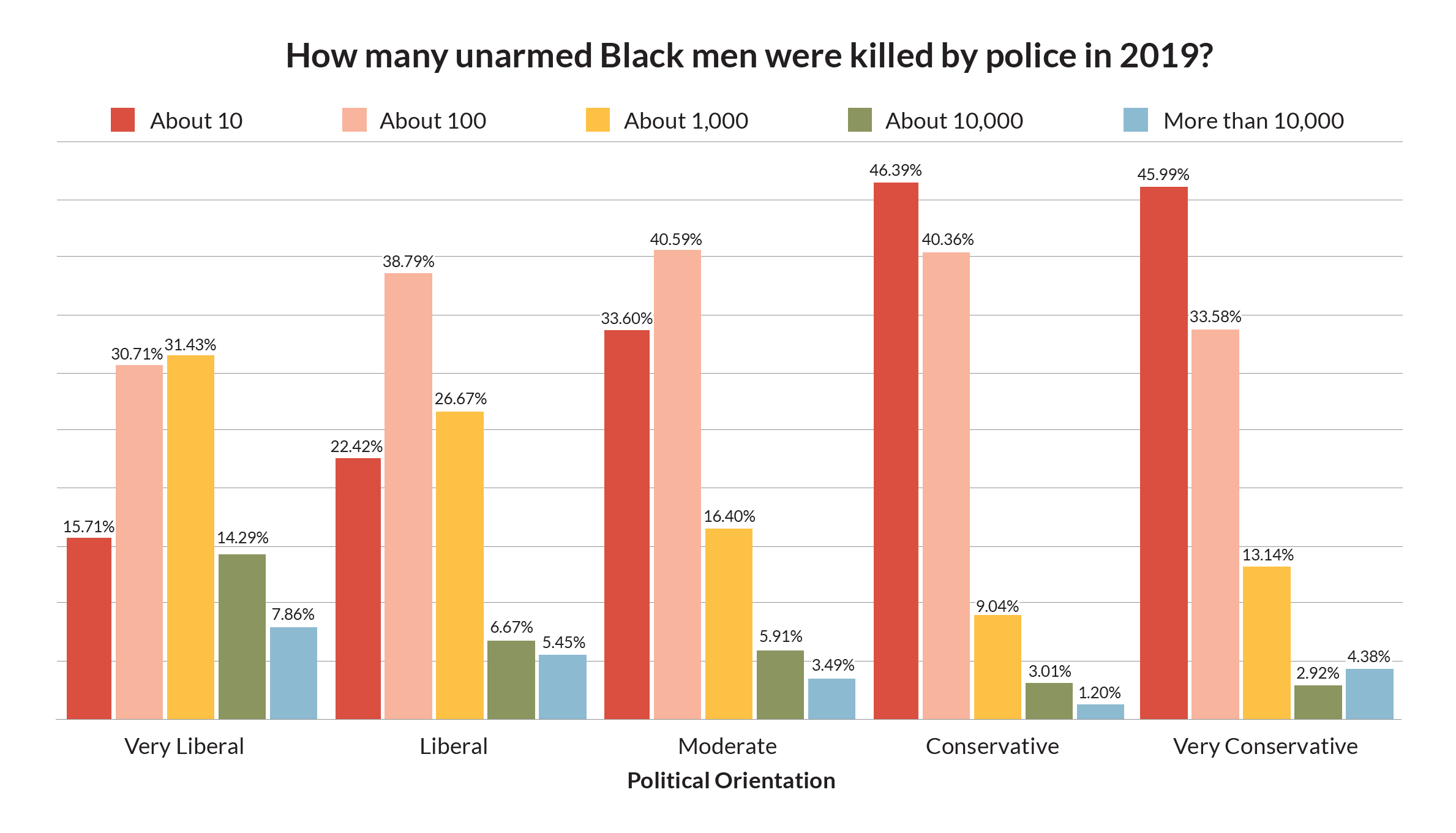
Figure 2
To understand what is happening we need to examine the issue empirically. In an initial study, I hypothesized: Is it possible that news media are misinforming us, causing us to believe the issue of race in the U.S. is worse than it actually is? Columbia University linguist John McWhorter points out12 that U.S. news tends to give extreme coverage to situations in which an unarmed Black citizen is killed by police, but ignores similar situations in which the victim is an unarmed White citizen, even when the horrifying footage is available to the public (e.g., the killings of Tony Timpa and Daniel Shaver). Because we tend to overestimate events we can easily remember—a phenomenon termed the availability heuristic—this leads us to think that shootings of unarmed Black individuals are common and shootings of unarmed White individuals are nearly unheard of. As reported in a Skeptic Research Center study published in Skeptic,13 most Americans vastly overestimate the frequency of police shootings of unarmed Black citizens and this may be one explanation for that. Figure 2 (above) shows that asymmetry by political orientation.
Actual data regarding police shootings of unarmed citizens are nuanced and controversial. For example, based on the Washington Post data, unarmed White citizens are shot more often than unarmed Black citizens, but proportionally Black citizens are overrepresented among shooting victims (see Figure 3).
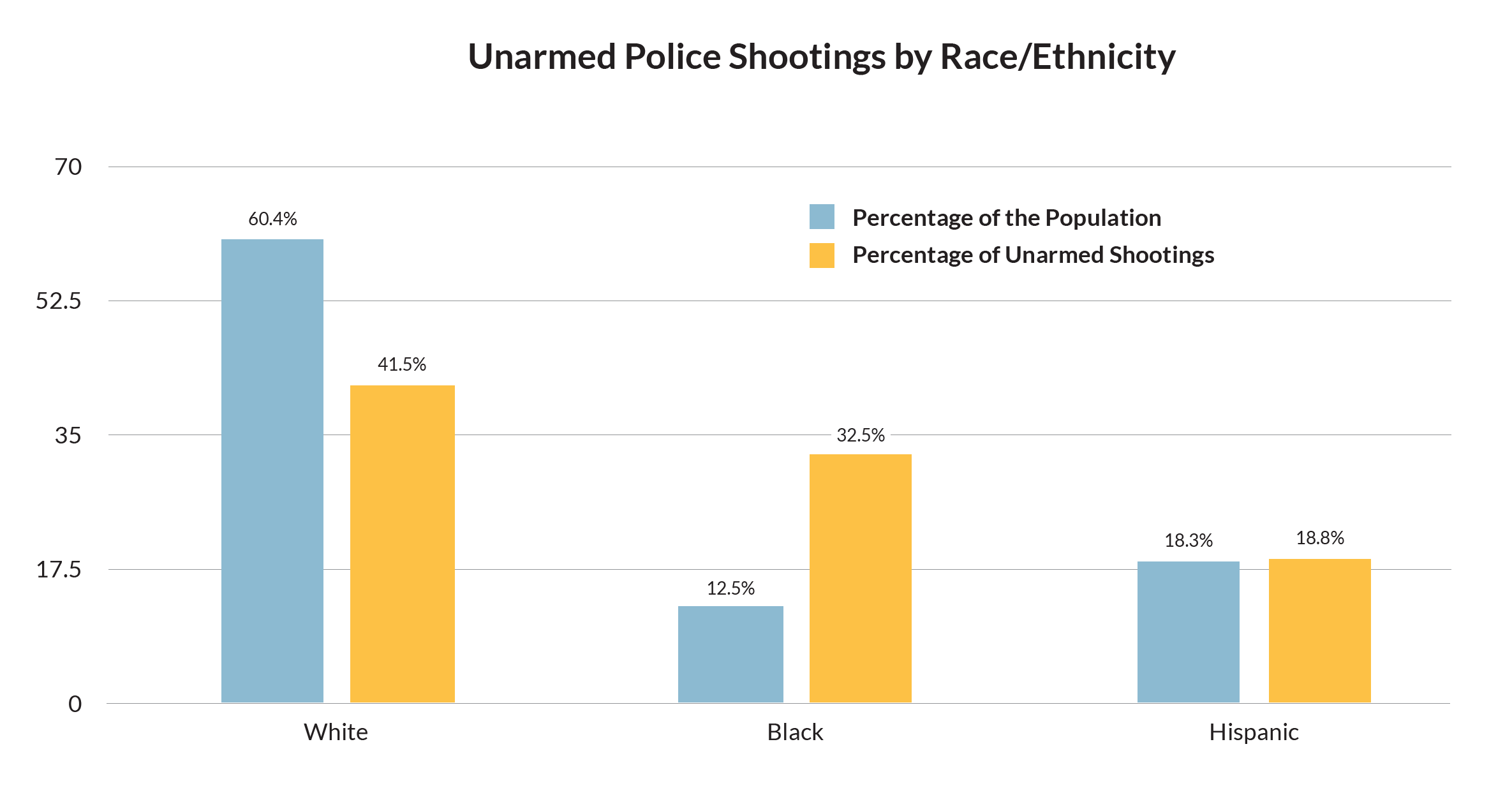
Figure 3
Such proportional differences look bad and are mostly what gets reported in the media, but they don’t tell the whole story. The base rate of police encounters and the fact that Black individuals are proportionally overrepresented among perpetrators of violent crime14 (see Figure 4) should be included in interpretation of the data. The political scientist Philip Tetlock has identified what he calls the “forbidden base rate effect,”15 which results from the fact that no two groups of people—Blacks and Whites, men and women, Protestants and Catholics, Jews and Gentiles, Yankee fans and Red Sox fans—are identical on any average measure. Base rate neglect is a common cognitive error most of us make, but base rates become taboo when discussing group differences related to sensitive and controversial issues, such as income, marriage, home ownership, and crime.
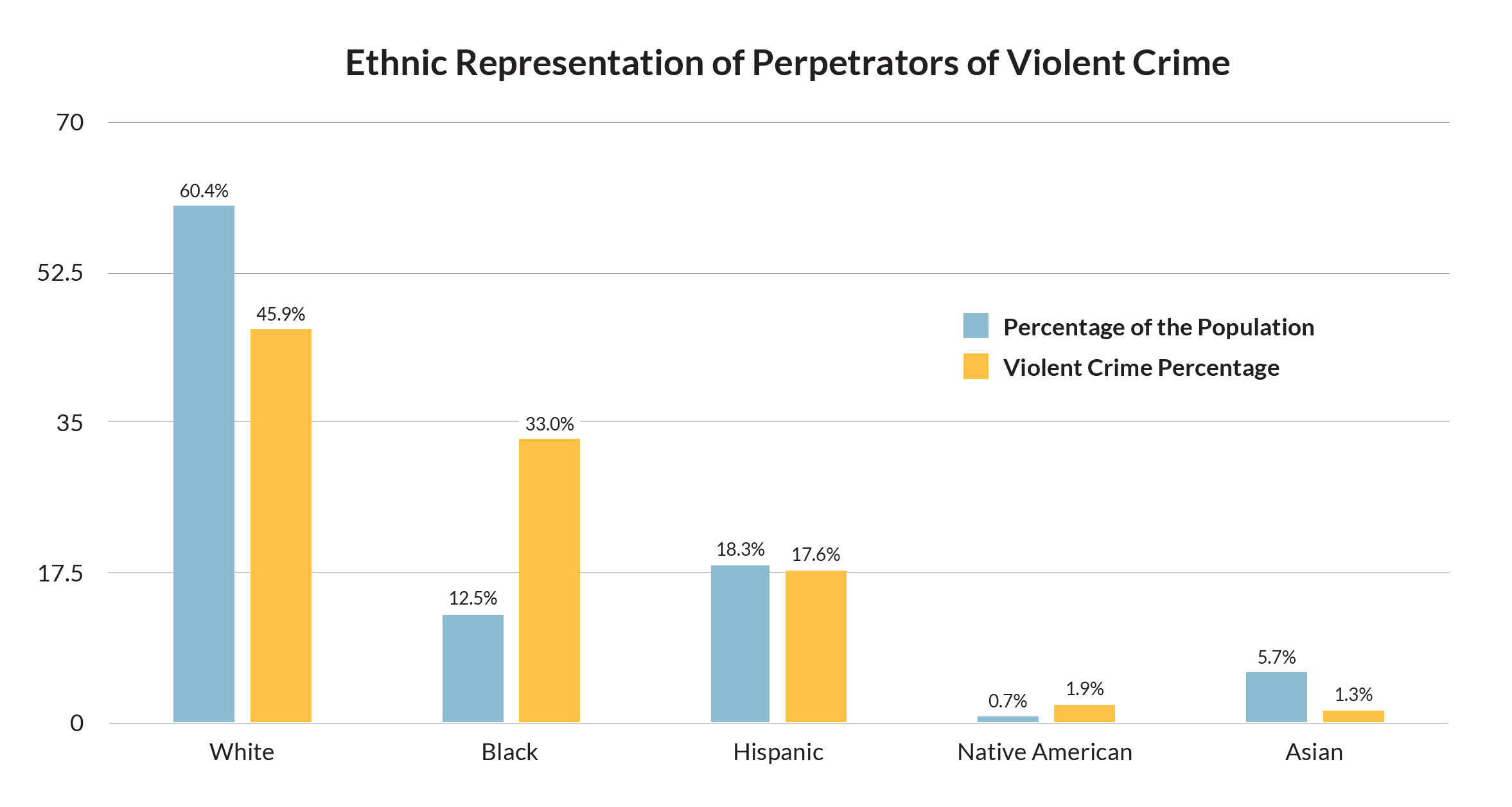
Figure 4
At this time, I believe the evidence suggests that it is socioeconomic class, rather than race per se, that is the real issue underlying both police violence and perpetration of crime. Indeed, some forthcoming research I have recently conducted with my colleagues suggests this to be the case. Although young Black men are overrepresented as crime perpetrators, once class factors are controlled for, race is no longer a predictor of violent crime. Similarly, other data we’ve collected suggests that factors such as community mental health predict police misconduct reports more than race does. In other words, a low-income White individual who suffers from mental illness and does not respond to police requests is likely to be treated similarly to a Black individual in the same circumstances. The data do not establish that Black men are inherently more prone to crime, but neither do they indicate that being Black results in an elevated risk of violence at the hands of police; whereas lower income and possibly bad mental health do seem to increase this risk. It is also worth noting that police shootings of unarmed women of any race are exceedingly rare, suggesting police shootings aren’t random and can be best explained as a function of perceived risk (men commit by far more violent crimes than women). According to the Washington Post database, from 2015–2021, only 15 White and 7 Black unarmed women were fatally shot by police compared to 160 White and 130 Black unarmed men. Most news media fail to report on these complexities and nuances of the data.
This brings us back to the matter of the perceived worsening of race relations and the question as to what extent it is due to actual circumstances in real life, news media coverage, or something else? The Kyle Rittenhouse trial and verdict illustrate how news media mishandling of complex details is related to many in the public being misinformed about the case.16 For example, the narrative that Rittenhouse “crossed state lines” with a weapon specifically seeking to kill others was not at all accurate, as became apparent in his trial. Is it possible news media is driving the decline in race relations?
In a recently published study,17 I sought to address this issue by examining how fluctuations in race relations were related to both actual fatal shootings of unarmed Black men, as well as news media coverage of police shootings. I investigated this based on (1) Civiqs polling,18 which continuously surveys opinions on race relations; (2) the aforementioned Washington Post database for fatal police shootings of Black men; and (3) the frequency of articles on “police shootings” published in the New York Times, for news media coverage.
I found that race relations were not correlated with actual fatal police shootings of Black men. So, at least on this issue, it would seem that perceived race relations are not related to actual real events. In contrast, I did find a correlation between news media coverage of police shootings and race relations. The correlation was small, but perceptions that race relations are getting worse were correlated with greater news media coverage of police shootings.
This finding suggests that our perceptions of race relations are more a factor of what is covered in news media than of events occurring in real life. However, as we all know, correlation does not equal causation. So, I sought to expand on this hypothesis by examining whether changes in news media coverage predicted changes in race relations. We might expect this to occur as people absorb news media coverage, perhaps with a certain delay (a day or a few weeks). Working under these assumptions, I did not find any significant association.
This suggests that race relations and news media coverage are correlated, but there was no evidence to suggest news media are causing race relations to decline. Rather, they are best understood as co-occurring phenomena. That is, it might be better to think of news media as pandering to a preexisting narrative rather than causing it to spring into being. Certainly, it might be desirable for news media to present only the verified facts and hew close to reality. However, news media is a business and any business survives (and prospers) when it gives the customers what they want.
My study has some obvious limitations. First, it only captured the years 2016–2021 when race relations had already declined. And it only considered the (relatively, especially as of late) left-leaning outlet, the New York Times. In a forthcoming analysis, I hope to analyze some data stretching back to the early 2000s and examine the impact of both left- and right-leaning media (such as Fox News) on race relations.
Part of the takeaway from this initial data is that our current crisis in race relations cannot be laid exclusively at the news media’s door, even though we can be critical of their role in perpetuating misinformation about race in America. As is often the case with complex social phenomena, the decline in race relations is undoubtedly multifaceted. Although specific events such as the election of a president attributed to xenophobic rhetoric, or the tendency of news media to embrace hoaxes such as that of the actor Jussie Smollett can all be identified as specific anecdotes on this downward trend, anecdotes are not sufficient to explain the decline. Indeed, they likely only reinforce our views. Some say, “What do you expect when people on the Right elect racist politicians?” or “What do you expect when people on the Left justify rioting and looting?” In so doing, we avoid a deeper understanding.
A comprehensive understanding of the decline in race relations since 2014 would undoubtedly need to consider multiple factors. These may include the availability heuristic and the negativity bias (“if it bleeds it leads”), the polarizing fracturing of news media, as well as an embrace of cynical, nihilistic theories of United States history on both the political Right (MAGA) and Left (1619 Project). It’s imaginable that much of our struggles can be understood as a class battle between elites who control media, academia, and corporations, regardless of race or ethnicity. Real issues such as income inequality likely play a role, but so too does the ideological capture of academia by activists embracing scientifically deficient theories.
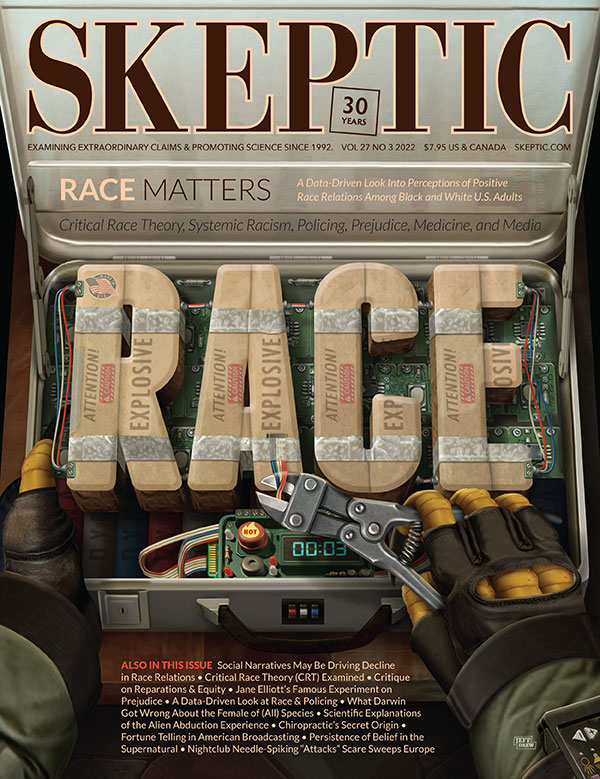
This article appeared in Skeptic magazine 27.3
Buy print edition
Buy digital edition
Subscribe to print edition
Subscribe to digital edition
Download our app
The current state of race relations is undoubtedly complex. However, I think we can reverse this trend and examine these very real and complex issues not only critically, but objectively. In future writings, I hope to elaborate on how I see the decline in race relations developing since 2014, perpetuated by the elite reaction to events such as the Kyle Rittenhouse trial, as well as how we can work to reverse these trends.
For now, we can conclude that national news media are only a small part of a much larger challenge. We should demand that our news media report the news more faithfully and end the “moral clarity” era of journalism that has created so much misinformation. However, if we wish to see an improvement in race relations, we must understand the post-2014 trend clearly, acknowledging both those very real problems that do exist as well as how ideologically distorted narratives, from both Right and Left, cause more harm than good by preventing effective actions to resolve them. ![]()
About the Author
Christopher J. Ferguson is a professor of psychology at Stetson University and licensed psychologist. He has done work on violent crime, media effects and societal panics for over two decades. He is author of the books How Madness Shaped History and Moral Combat: Why the War on Violent Video Games is Wrong as well as the historical mystery novel Suicide Kings. He lives in Orlando with his wife and son.
References
- https://bit.ly/3IljV6P
- https://bit.ly/3dfiDMr
- https://bit.ly/3Iiuc3W
- https://bit.ly/3Gg9JLf
- Charlesworth, T.E.S., & Banaji, M.R. (2019). Patterns of Implicit and Explicit Attitudes: I. Long-Term Change and Stability From 2007 to 2016. Psychological Science, 30(2), 174–192. https://doi.org/10.1177/0956797618813087
- https://bit.ly/3GbjLgv
- https://wapo.st/2ZUDD8i
- Reilly, W. (2020). Taboo: 10 Facts You Can’t Talk About. Regnery Publishing.
- https://bit.ly/3G3913Q
- https://bit.ly/3psJhar
- https://bit.ly/3lx7dbB
- https://bit.ly/3df9nIc
- https://bit.ly/3OvyEid
- Beck, A.J. (2021). Race and Ethnicity of Violent Crime Offenders and Arrestees, 2018. Bureau of Justice Statistics.
- https://bit.ly/31sArAY
- https://bit.ly/3rzUatO
- https://bit.ly/31vyR1d
- https://bit.ly/3pnUCbM
This article was published on January 7, 2023.







